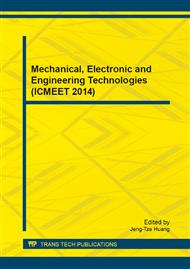p.352
p.356
p.360
p.367
p.371
p.375
p.379
p.383
p.387
Indoor Autonomous Navigation Technology Research Based on Lidar for Quad-Copter Aerial Robot
Abstract:
An indoor autonomous navigation system without GPS has been developed, based on the platform of quad-copter, which may fulfill the task of searching, identifying and entering the target room in a building with multi-rooms corridor. A pose sensor was utilized to stabilize the aircraft. The SLAM (Simultaneous Localization and Mapping) and plan route in unknown environment have been created by a 2D lidar. A calibrated monocular camera has been used to recognize different marks to make sure the vehicle to enter the target room. The test result showed that the indoor autonomous navigation technology based on lidar for quad-copter aerial robot is feasible and successful.
Info:
Periodical:
Pages:
371-374
Citation:
Online since:
April 2014
Authors:
Price:
Сopyright:
© 2014 Trans Tech Publications Ltd. All Rights Reserved
Share:
Citation:


